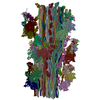+Search query
-Structure paper
| Title | Cryo-EM structure of the human cardiac myosin filament. |
|---|---|
| Journal, issue, pages | Nature, Vol. 623, Issue 7988, Page 853-862, Year 2023 |
| Publish date | Nov 1, 2023 |
 Authors Authors | Debabrata Dutta / Vu Nguyen / Kenneth S Campbell / Raúl Padrón / Roger Craig /  |
| PubMed Abstract | Pumping of the heart is powered by filaments of the motor protein myosin that pull on actin filaments to generate cardiac contraction. In addition to myosin, the filaments contain cardiac myosin- ...Pumping of the heart is powered by filaments of the motor protein myosin that pull on actin filaments to generate cardiac contraction. In addition to myosin, the filaments contain cardiac myosin-binding protein C (cMyBP-C), which modulates contractility in response to physiological stimuli, and titin, which functions as a scaffold for filament assembly. Myosin, cMyBP-C and titin are all subject to mutation, which can lead to heart failure. Despite the central importance of cardiac myosin filaments to life, their molecular structure has remained a mystery for 60 years. Here we solve the structure of the main (cMyBP-C-containing) region of the human cardiac filament using cryo-electron microscopy. The reconstruction reveals the architecture of titin and cMyBP-C and shows how myosin's motor domains (heads) form three different types of motif (providing functional flexibility), which interact with each other and with titin and cMyBP-C to dictate filament architecture and function. The packing of myosin tails in the filament backbone is also resolved. The structure suggests how cMyBP-C helps to generate the cardiac super-relaxed state; how titin and cMyBP-C may contribute to length-dependent activation; and how mutations in myosin and cMyBP-C might disturb interactions, causing disease. The reconstruction resolves past uncertainties and integrates previous data on cardiac muscle structure and function. It provides a new paradigm for interpreting structural, physiological and clinical observations, and for the design of potential therapeutic drugs. |
 External links External links |  Nature / Nature /  PubMed:37914935 / PubMed:37914935 /  PubMed Central PubMed Central |
| Methods | EM (single particle) |
| Resolution | 6.01 - 7.9 Å |
| Structure data | EMDB-29722, PDB-8g4l:  EMDB-29726: Cryo-EM structure of the human cardiac myosin filament  EMDB-29734: Cryo-EM structure of the human cardiac myosin filament |
| Source |
|
 Keywords Keywords |  CONTRACTILE PROTEIN / CONTRACTILE PROTEIN /  cardiac / cardiac /  myosin / myosin /  filament / filament /  complex complex |
 Movie
Movie Controller
Controller Structure viewers
Structure viewers About Yorodumi Papers
About Yorodumi Papers






